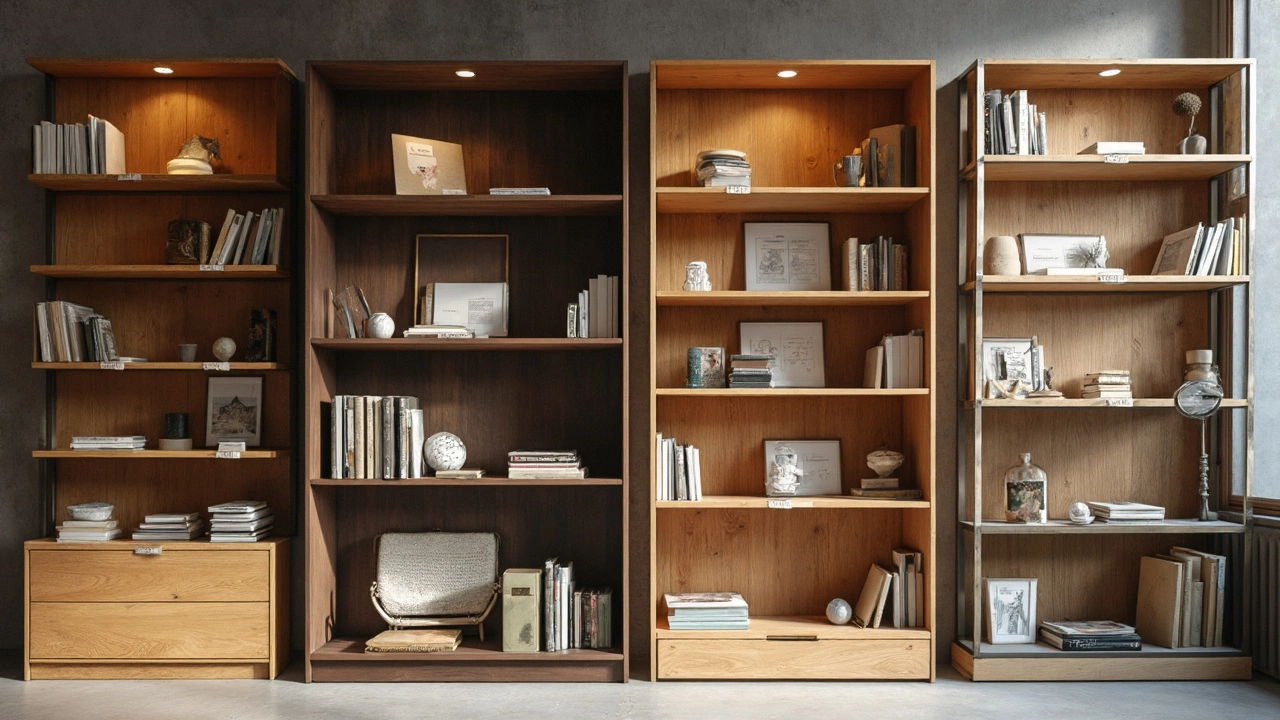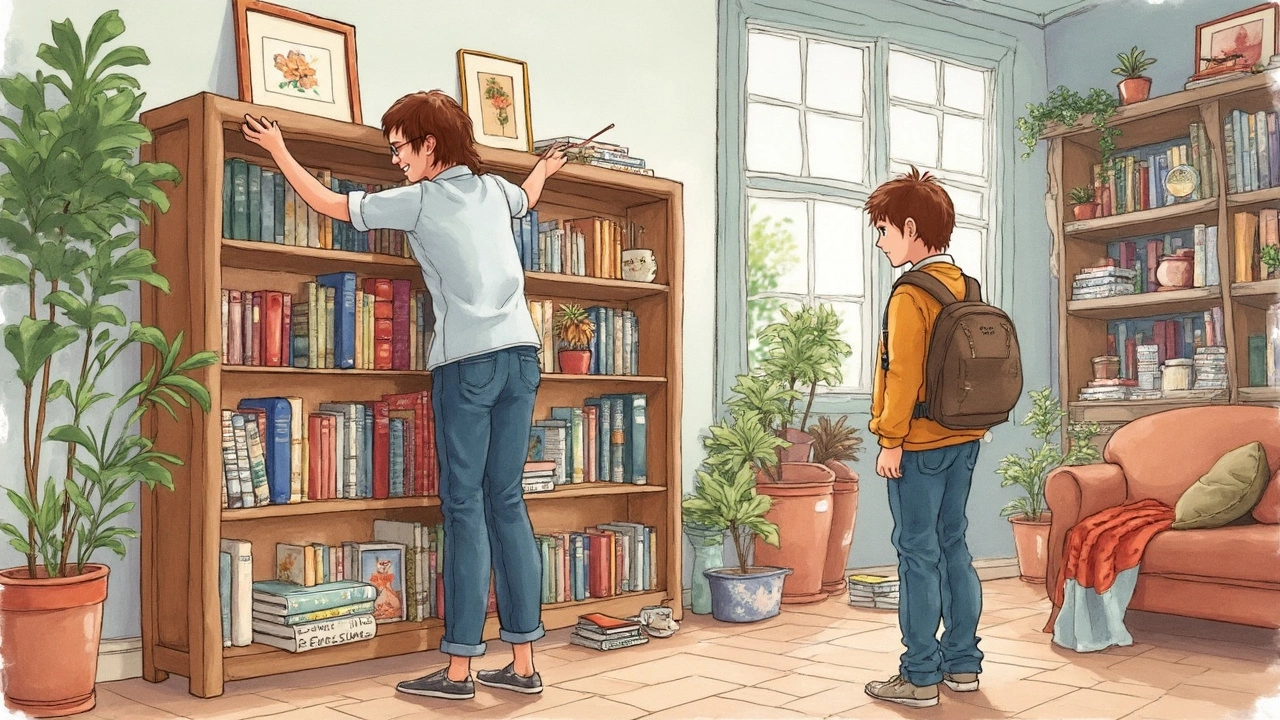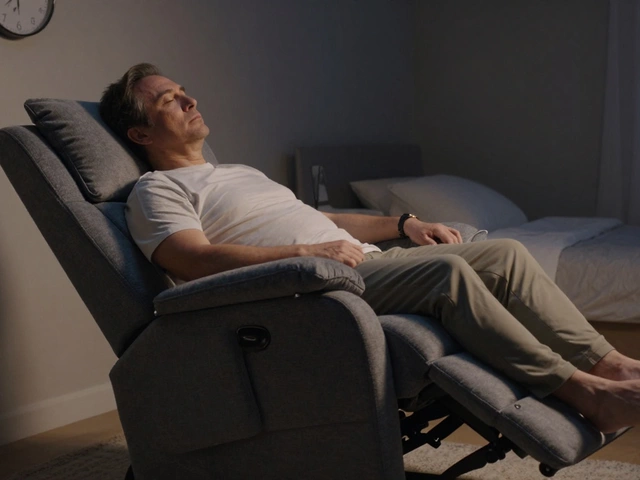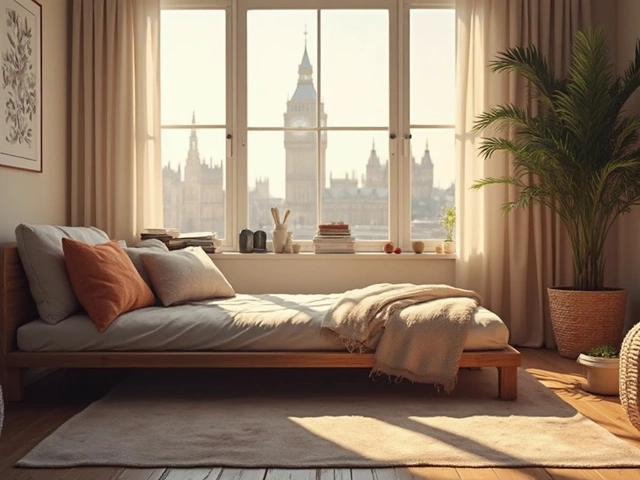Ever notice how price tags on bookshelves seem all over the place? You might see a simple shelf for less than a night at the movies, then walk a few steps and find something five or ten times more expensive. The wild price swings aren’t just about paying for a “brand name”—it actually comes down to real stuff like wood type, shelf thickness, and how those things are put together.
If you’re moving places or finally giving your books a home, you probably want something that won’t sag or tip over in a month. At the same time, nobody wants to get ripped off. It helps to know what’s out there, what actually makes a bookshelf more (or less) expensive, and why some options last forever while others fall apart if you look at them wrong. There are some genuine tricks for getting quality without breaking the bank, and honestly, avoiding a bad shelf is a lot cheaper than replacing a pile of snapped particleboard a year later.
- What Really Decides the Price?
- Budget vs. Expensive: What’s the Difference?
- Popular Types and Their Price Ranges
- Where to Get the Best Deals
- Tips to Save Money (and Headaches)
What Really Decides the Price?
The price of a bookshelf can swing wildly depending on a bunch of real factors. The biggest ones? Material, size, construction quality, brand, and sometimes just simple supply and demand. That’s it—there’s no secret handshake or hidden formula.
- Material: Real solid wood is always pricier than particleboard or MDF. Oak, walnut, and maple top the charts. Laminates and particleboard are cheaper, but they dent, swell, and sag way easier.
- Size: A small two-shelf unit is going to cost far less than a massive six-foot, wall-to-wall setup, even from the same store.
- Construction Quality: Stuff like thick shelves, extra supports, and real joinery (look for dovetail joints!) adds to the cost, but also means the shelf won’t collapse with a full load.
- Finish and Style: White paint or fake-wood vinyl is cheap. Intricate molding, fancy stains, or custom colors mean a bigger bill.
- Brand and Where You Buy: Big brands or tiny boutique makers usually charge more. Flat-pack DIY shelves are usually cheaper online or at places like IKEA, while a solid piece from a local shop might run much higher.
Here’s a quick breakdown so you can eyeball where your dream shelf might land:
| Type/Material | Average Price (2025) |
|---|---|
| Particleboard or MDF | $30 – $150 |
| Laminate (cheap wood + vinyl covering) | $60 – $250 |
| Solid Pine | $120 – $400 |
| Solid Oak/Maple/Walnut | $200 – $900+ |
| Custom or Designer Piece | $700 – $3,000+ |
Other sneaky price factors? Adjustable shelves (usually more spendy), built-in lighting, or anything labeled “mid-century modern” or “industrial.” That trendy finish might add $50 to $200 for basically the same structure.
Bottom line: Take a second to check what you’re really paying for before dropping big money. Sometimes a low price means you’ll be hunting for another shelf next year.
Budget vs. Expensive: What’s the Difference?
The sticker shock when you look at two different bookshelves can be real. At first glance, they might look pretty similar, but the guts tell a totally different story. A $40 shelf from a discount store and a $400 solid wood bookcase aren’t even playing the same sport, let alone in the same league.
So, where does the price hike actually come from? Here’s the real breakdown:
- Materials: Cheap shelves use particleboard or thin MDF, while pricier ones go for solid wood (like oak, walnut, or maple) or metal. Solid wood not only looks better, but it also lasts way longer and can handle more weight without warping or breaking.
- Construction: Budget bookcases often use little pegs, cam locks, or glue. High-end versions have actual joinery like dovetails or mortise-and-tenon, which hold together better and don’t get wobbly.
- Finish: You’ll spot wood veneers on most low-end shelves. Real hardwood shows off the real grain, feels smoother, and resists scratches and stains more than the fake stuff.
- Thickness: Thin shelves are bendy. More expensive bookcases use thicker panels for both the frame and shelves, so you don’t have to worry when you load them with heavy hardcovers or textbooks.
- Design and Extras: Adjustable shelves, backing boards that don’t wiggle, anti-tip kits, and deeper shelves all make life easier but ramp up cost on pricier models.
Take a look at the difference in features:
| Feature | Budget Bookshelf (~$50) | Expensive Bookshelf (~$500) |
|---|---|---|
| Material | Particleboard / MDF | Solid wood (e.g., oak, walnut) |
| Shelf Thickness | 1/2 inch | 3/4 - 1 inch |
| Finish | Paper laminate / veneer | Real wood stain / lacquer |
| Weight Limit | 15-25 lbs per shelf | 50-100 lbs per shelf |
| Assembly | DIY flat-pack | Partially or fully assembled |
The biggest mistake people make? Assuming the bookshelves from a budget aisle will handle a big collection. Cheap shelves can sag or break under heavy books, while solid wood gives you peace of mind (and looks way better). If you’re short on cash, read the weight recommendations closely and don’t expect particleboard to last for years—especially if you plan to move or rearrange your room a lot.

Popular Types and Their Price Ranges
When you hit the furniture aisle, it helps to know what you’re looking at. There are a few classic bookshelf styles that pop up everywhere—and the prices can swing wildly between them.
Bookshelves come in materials that set the base price: cheap particleboard, solid pine, or fancy hardwoods like oak or walnut. Particleboard (think IKEA Billy bookcases) is the budget king, usually running $30 to $80 for a basic 3-5 shelf unit. Pretty decent if you need something quick and don’t plan on moving it around a lot.
Next up is solid wood, which bumps the cost to $150-300 for a midsize shelf. People pay more for these because they really can last ages. Maple and oak are common picks—it’s not just about looks, but durability. If you see “engineered wood” or “composite,” expect something stronger than particleboard but lighter on your wallet than real hardwood.
Ladder shelves, where the shelves step up at an angle, are trendy and usually smaller. You’ll see these from $60 for something basic, up to $250 if the materials are fancier. They save floor space and look pretty modern, but always check the shelf depth—some are too shallow for bigger books.
Corner bookcases fill awkward spots. Prices here go anywhere from $70 for a smaller, MDF version to $200 or more for real wood. If you’ve got a tricky room layout, a corner shelf can make life easier, but costs creep up fast if you want something that matches your other furniture.
If you want to go big, wall units or library bookcases can be $350 all the way into the thousands. You’re paying for size, extra features like glass doors, and sturdier construction. Shops like Pottery Barn or custom woodworking companies sell these for the folks who have serious book collections (or want their homes to look like something out of a movie).
- Particleboard basics: $30-$80.
- Solid wood shelves: $150-$300+.
- Ladder shelves: $60-$250.
- Corner bookcases: $70-$200+.
- Large wall units: $350 and up, sometimes well over $1,000.
The price really boils down to the quality, size, and materials. If you just want somewhere to toss paperbacks, the budget options do the trick. For long-term use or heavy books, it might pay to invest a bit more upfront.
Where to Get the Best Deals
If you’re on the hunt for a solid bookshelves bargain, you’ve got more choices than just your big box store down the road. Places like IKEA are famous for wallet-friendly shelves, with basic models like the BILLY bookcase starting around $60. But IKEA’s not your only option, and sometimes the best deal isn’t actually the cheapest tag—it’s what lasts longest for the money.
Here’s something interesting: online retailers like Amazon or Wayfair will show you a ton of choices with reviews from real people. This is gold when you’re trying to avoid the nightmare of a bookshelf that bows under the weight of a paperback. Local furniture stores also run regular sales, so don’t skip a quick call or web search before you head out. Target and Walmart carry a wide range of bookshelves too, often under $100 for a basic unit, especially during back-to-school season.
If you want to snag a real bargain, check out these spots:
- Facebook Marketplace and Craigslist: Score secondhand or even like-new bookshelves—sometimes people just want them gone, so you can negotiate the price down.
- Thrift Stores: Goodwill and Habitat for Humanity ReStores often have sturdy shelves for $20 or less. No delivery, but that’s what friends and borrowed trucks are for.
- Flat-Pack Giants: IKEA, Target, and Walmart let you haul home a brand new shelf for less than a dinner out—though expect some assembly and sometimes thinner panels.
- Online Retailers: Amazon and Wayfair have regular deals, and you can filter by price, material, size, and reviews to dodge buying a dud.
If you’re going for something fancier—like solid wood or a custom job—look for local carpenters or woodworking shops. You might spend more up front, but you’ll often get something that doesn’t wobble (and gives you bragging rights).
Here’s a quick breakdown of what you’ll see price-wise from popular retailers as of early 2025:
| Retailer | Typical Price Range (Basic to Premium) | Delivery Options |
|---|---|---|
| IKEA | $60 - $300 | Store pickup or home delivery for a fee |
| Target | $30 - $350 | Free shipping on many items, in-store pickup |
| Amazon | $25 - $400+ | Fast shipping, especially with Prime |
| Wayfair | $40 - $1,000+ | Many free shipping deals, big selection |
| Thrift Stores | $10 - $60 | Local pickup only |
A quick tip: always double-check return policies, especially with online buys. And if you’re buying used, check for wobbles and deep scratches before you hand over any cash. With a bit of hunting, you can grab a shelf that does the job and keeps money in your pocket.

Tips to Save Money (and Headaches)
Before you rush out and buy the first shelf you see, slow down and think about a few things. It’s easy to spend too much or buy the wrong kind of bookshelf and deal with the hassle later. Here’s how you can dodge those headaches and keep more cash in your pocket.
- bookshelves out of solid wood usually last way longer than cheap particleboard, but you can score deals at thrift stores or used furniture shops. Sometimes you’ll find real wood shelves for less than the flat-pack stuff at big box stores.
- Check online marketplaces like Facebook Marketplace, Craigslist, or your local Buy Nothing group. People give away or sell perfectly good bookcases every day, sometimes just because they want to get rid of them fast.
- Measure your space—twice—before shopping. A shelf that doesn’t fit is money wasted, and returns can be a pain, especially with heavy furniture.
- If you go the DIY route, buying your own lumber and hardware from stores like Home Depot or Lowe’s can save you a ton, especially if you want custom sizes. Basic tools and a few hours can get you something sturdy and way cheaper than high-end retailers.
- Watch for big furniture sales, especially around holidays like Memorial Day or Labor Day. Retailers roll out their best discounts, and you can snag legit bargains on quality shelves.
Don’t just look at the sticker price. Sometimes cheap shelves end up costing more if you have to replace them every year. Reviews are gold—look for comments about stability and sagging, not just how the bookshelf looks out of the box.
If you’re buying online, always check the return policy. Some flat-pack shelves can arrive damaged or with missing parts. Good companies make returns easy, but plenty of sellers don’t. And don’t forget coupons or cashback deals—you’d be surprised how much that can shave off the final price.



